Mark Sisson's Blog, page 91
October 30, 2019
Olive Oil Is Here! + a Giveaway
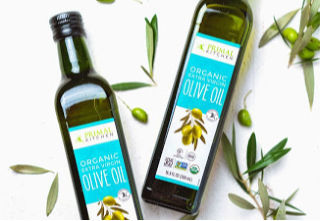 I’ve always been an avocado fan—and, by extension, an avocado oil proponent. I enjoy the buttery flavor and cooking versatility. I love avocado oil—but…it’s not exclusive.
I’ve always been an avocado fan—and, by extension, an avocado oil proponent. I enjoy the buttery flavor and cooking versatility. I love avocado oil—but…it’s not exclusive.
Anyone who knows me well has seen how much I enjoy Mediterranean food, and for that extra virgin olive oil can’t be beat. It’s been on my list for a while now—create the olive oil I want to eat with every Mediterranean meal. I took my time sampling and choosing for sure, but I couldn’t be happier with the result.
And I hope you’ll enjoy it, too. Bright, peppery, and nuanced, Primal Kitchen® Organic Extra Virgin Olive Oil is a blend of Spanish and Tunisian olives—perfect for dressings, dipping, and light cooking.
I love using it in recipes where I can really taste and savor it—from fish to lamb to a tomato and cucumber salad and more. I’ve said before that the flavor of a good extra virgin olive oil is nuanced enough to elevate the simplest dishes, and that’s what I’m happy to offer—with the same careful dedication to quality I ensure with all Primal Kitchen products: Whole30 Approved®, Certified Paleo, Keto Certified, Certified Organic, and Non-GMO Project Verified, so you know you’re getting the best.
Now For the Giveaway…
How do you use extra virgin olive oil in your Primal and keto cooking? Tell me in the comment section—OR—suggest a future recipe or topic for the blog.
Be sure to comment by midnight PDT Friday (11/1/19) to be eligible. (U.S. only for this one, I’m afraid.) I’ll choose 3 random commenters to receive a bottle of Primal Kitchen Organic Extra Virgin Olive Oil.
Thanks for stopping in. I’ve got a feature coming up. ‘Til then, have a great day, everybody.
The post Olive Oil Is Here! + a Giveaway appeared first on Mark's Daily Apple.



October 29, 2019
Ancestral Resting Positions: Video Guide
 Earlier this year, I collaborated on a pair of papers (1, 2) with Matthew Wallden, Global Head of Institute of Education for the Chek Institute and an absolute obsessive when it comes to applying ancestral lessons to modern life. The papers were all about how humans today are failing to honor their tissues at rest: by sitting in chairs, slumping on couches, and slouching at the computer. The sad fact is, we’re ignoring the myriad ancestral or archetypal resting positions that humans have been using for hundreds of thousands of years, and this is having huge consequences on our health.
Earlier this year, I collaborated on a pair of papers (1, 2) with Matthew Wallden, Global Head of Institute of Education for the Chek Institute and an absolute obsessive when it comes to applying ancestral lessons to modern life. The papers were all about how humans today are failing to honor their tissues at rest: by sitting in chairs, slumping on couches, and slouching at the computer. The sad fact is, we’re ignoring the myriad ancestral or archetypal resting positions that humans have been using for hundreds of thousands of years, and this is having huge consequences on our health.
I wrote a blog post explaining the consequences. Not only are modern resting positions destroying the health and viability of our connective tissues and muscle function, they’re even inhibiting our ability to control blood glucose levels. We’re getting injured more often, ending up with terrible conditions like osteoarthritis, and we’re making our already substandard blood glucose control even worse.
The point of all this is that sitting in one single position with the majority of our tissues supported by furniture is incredibly harmful. Instead, we should be shifting our body from position to position. We should be stretching this muscle in one position and stretching the opposing muscle in the next position. Our rest should be productive. It shouldn’t be turning off the entire body for 8 hours. It should be resting one piece while engaging another—and switching things up constantly. Even our rest, whether from our workouts or daily life, should involve movement, in other words.
Despite being “ancestral” or “archetypal,” it’s a foreign concept if you’ve never done it. These can be hard to visualize through text alone. So I’ve made a helpful video showing some of them. As you can see, these positions aren’t always “easy” or “natural,” especially if you’re coming from a background of modern resting positions (like all of us). But do what you can, and work toward achieving these resting positions. Even breaking up all that sitting with an hour or two of shifting ancestral positions on the floor will be a huge help.
I hope you enjoy the video, and I hope you give these a shot. You can also listen to my podcast with Matt here.
Let me know what you think. Which of the postures do you see your incorporating—now or moving forward?
References:
Wallden, Matthew, Mark Sisson, “Biomechanical attractors—A paleolithic prescription for tendinopathy & glycemic control.” Journal of Bodywork and Movement Therapies, Volume 23, Issue 2, 366 – 371.
Wallden, M., Mark Sisson, “Modern disintegration and primal connectivity.” Journal of Bodywork and Movement Therapies, Volume 23, Issue 2, 359 – 365.

The post Ancestral Resting Positions: Video Guide appeared first on Mark's Daily Apple.



October 28, 2019
I Wanted To Get To the Root Cause
It’s Monday, everyone! And that means another Primal Blueprint Real Life Story from a Mark’s Daily Apple reader. If you have your own success story and would like to share it with me and the Mark’s Daily Apple community please contact me here. I’ll continue to publish these each Monday as long as they keep coming in. Thank you for reading!

Yup, success stories are back! And I’m looking for more. Follow-ups, mid-progress reflections—every story at every stage has the potential to inspire folks out there who are getting started or contemplating a new beginning. Contact me here to share your story—long or not so long. You never know who you’ll impact by doing it. Enjoy, everyone!
I was always interested in healthy food, exercising, and learning what I could do to look young and healthy. As a kid, our household was filled with veggies and we ate couscous, buckwheat, and a variety of salads, which were not that common back in the 90’s in Hungary. I also did athletics during elementary school and have loved running ever since. Still, I had times when I struggled with weight issues.
Honestly, I had no idea what was good for my body or how to listen to it.
I ate way healthier than my friends or people around me but still experienced digestive issues, bloating, and headaches quite frequently. It was hard for me to lose weight, but I thought to myself: this is part of life and I am just not lucky.
Then in 2014, I was diagnosed with Hashimoto’s disease, which explained a lot of my symptoms. I visited many doctors, but did not get the answers I was looking for. They just told me to take thyroid hormones, saying it’s nothing serious and not to worry. But I wanted something more—an explanation why this happened to me.
I wanted to get to the root cause, so I started investigating and looking for information on the internet. That’s when I came across functional diagnostic nutrition and learned that besides my genetic predisposition, I contributed to my illness with my eating choices and my inability to handle stress well.
My love for this new information and how powerful our food choices are started to open my eyes and I wanted to learn even more. I realized that there are many people out there with similar issues who might not speak English and cannot read the books I had found.
I wanted to find a way to help them.
That’s when I started to search for schools that would give me the background in science I was looking for and came across the Primal Health Coach Institute.
I read reviews and contacted people who already had this certificate. I liked the fact that PHCI had a coaching aspect to their program as well. So, I jumped right in and loved the course very much. It was never a burden to sit down and learn, even after a long day of work.
After graduating in the fall of 2018, I created a 6-Week Lifestyle Change Program which could be adjusted to the needs of my clients. My goal is to make people aware of how primal living can help them feel and live better.
Carmen Fodróczy
Connect with her on Instagram and Facebook
Carmen’s listing in the Primal Health Coach Institute Directory


The post I Wanted To Get To the Root Cause appeared first on Mark's Daily Apple.



October 27, 2019
Harvest Steak Salad
 Hearty salads have the best of all worlds: ample protein, copious vegetables, and big flavor. And when they’re seasonally inspired? All the better…
Hearty salads have the best of all worlds: ample protein, copious vegetables, and big flavor. And when they’re seasonally inspired? All the better…
We’re loving this earthy autumn dish right now. Seared steak, fall vegetables and tangy mustard vinaigrette—together they make the perfect salad supper.
Servings: 3
Prep Time: 30 minutes
Cook Time: 90 minutes
Ingredients:

Salad:
3 cups cubed Butternut Squash
1 large Delicata Squash, seeds removed and sliced into rings (about 1.5-2 cups)
1 head Cauliflower, cut into florets
1 lb. Brussels Sprouts, halved
1 Tbsp. chopped Fresh Rosemary
4 cloves Garlic, grated
3 cups chopped Lacinato Kale
1/4 cup Primal Kitchen® Avocado Oil or Olive Oil
Salt and Pepper
1 medium Apple, quartered and thinly sliced
Steak:
1 lb. Tri-Tip Steak (but feel free to use another cut like sirloin, skirt, etc.)
1 Tbsp. Primal Kitchen Avocado Oil
1/2 Tbsp. Red Wine Vinegar
2 cloves Garlic, grated
Salt and Pepper
Dressing:
3 Tbsp. Olive Oil
2.5 Tbsp. Apple Cider Vinegar
1-1.5 tsp. Primal Kitchen Spicy Dijon Mustard
1 clove Garlic, grated
1 tsp. Honey (optional)
Salt and Pepper
Instructions:
Preheat your oven to 375 degrees Fahrenheit. Toss the butternut and delicata squash with 1.5 tablespoons of avocado oil and a sprinkle of salt and pepper. Lay the squash pieces on a parchment covered sheet pan in a single layer. Roast for 20 minutes, flip the squash over and roast for an additional 20 minutes, or until the squash is nicely roasted.
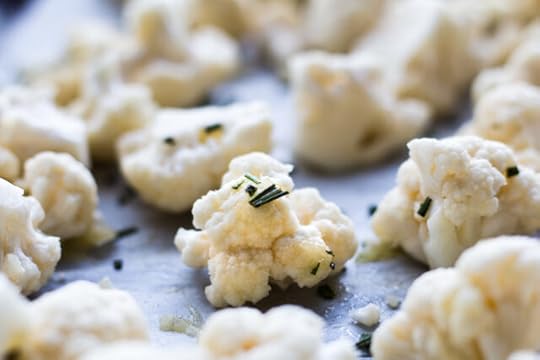
Toss the brussels sprouts and cauliflower florets in 1.5 tablespoons of oil, rosemary, garlic, and a pinch of salt and pepper. Lay the brussels sprouts cut side down on a parchment covered sheet pan. Roast for 20 minutes, or until the underside of the Brussels sprouts are golden, then flip over and roast for an additional 10 minutes or until tender.
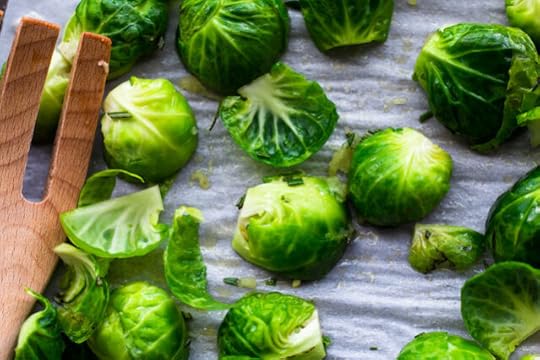
Massage the chopped kale in the last tablespoon of oil and a pinch of salt and arrange on a sheet pan. Roast for around 10-15 minutes.
Lay the cauliflower on another sheet pan and roast for 20 minutes. Give the florets a shake or flip and continue roasting until browned and tender.
Place a seasoned cast iron pan in the oven to preheat for 15-20 minutes. In a small bowl, combine the avocado oil, red wine vinegar, salt and pepper. Toss the steak in the mixture and allow it to marinate for about 10 minutes.

Once the pan is very hot, place it over a burner on medium heat. Add the steak and sear it for 1-2 minutes on each side. Transfer the pan to the oven and continue cooking until it reaches your desired internal temperature (125 degrees for rare, 135 degrees for medium-rare, 145 degrees for medium). Remove the steak from the pan and allow it to rest for 10 minutes before slicing.
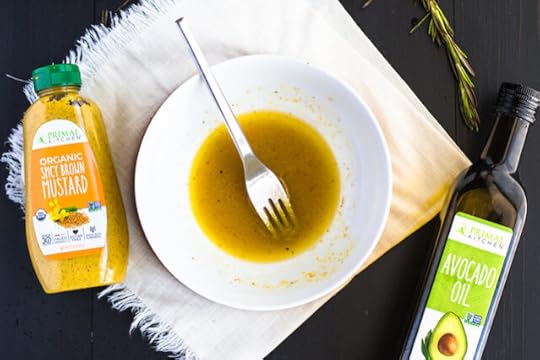
To make the dressing, whisk all of the dressing ingredients together and add salt and pepper to taste.
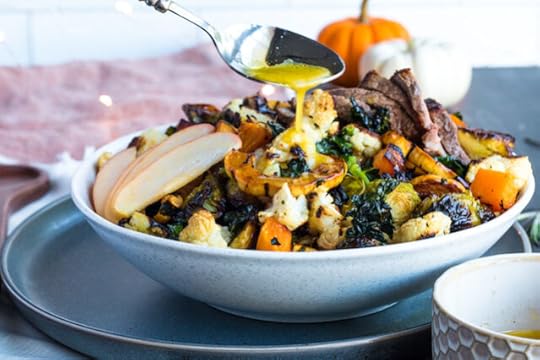
Combine all of the roasted vegetables together in a large bowl. Top with the sliced steak and apple slices and drizzle on the dressing.
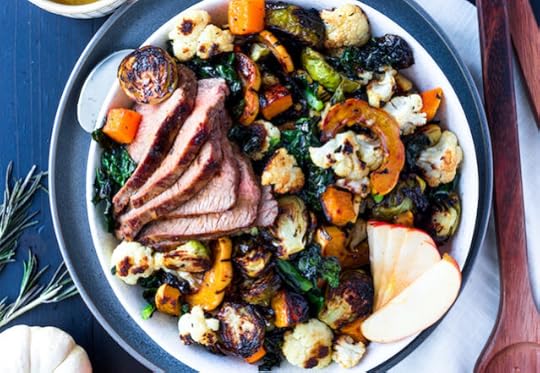
Nutrition Information per serving (¼ of recipe):
Calories: 618
Total Carbs: 48 grams
Net Carbs: 35 grams
Fat: 35 grams
Protein: 35 grams

The post Harvest Steak Salad appeared first on Mark's Daily Apple.



October 25, 2019
Weekly Link Love — Episode 52

Research of the Week
In an Iranian study, fast food—but not sugary beverages and salty snacks—is strongly associated with liver enzyme elevation.
Neanderthals used tar to bind arrow heads to shafts.
Overweight people tend to accumulate fat in their lungs as well, raising asthma risk.
Pro footballers (soccer players) have an elevated risk of neurodegenerative disease.
New Primal Blueprint Podcasts

Episode 383: Janie A. Bowthorpe: Host Elle Russ chats with thyroid patient advocate and author Janie A. Bowthorpe M.Ed.

Episode 384: 10 Awesome New Fitness Trends: Host Brad Kearns takes you through 10 exciting new fitness trends.

Primal Health Coach Radio, Episode 31: Laura and Erin chat with Carmen Hunter, who specializes in helping clients break through their comfort zones.
Each week, select Mark’s Daily Apple blog posts are prepared as Primal Blueprint Podcasts. Need to catch up on reading, but don’t have the time? Prefer to listen to articles while on the go? Check out the new blog post podcasts below, and subscribe to the Primal Blueprint Podcast here so you never miss an episode.
Media, Schmedia
Could a 5-hour workday work?
Sociologist goes back to school to learn genetics to disprove “nature over nurture,” ends up confirming it.
Interesting Blog Posts
It’s a shame that we even need things like “adult recess.”
Physicians are burnt out.
Social Notes
You’ll never guess what happened to diabetes incidence after Mauritius swapped out palm oil for soybean oil.
Is Oslo planning on banning meat in school lunches—even those brought from home?
Everything Else
Kellogg’s will no longer market sugary cereals as “healthy.”
Review of “Game Changers.”
Why there’s no “one size fits all” diet.
Things I’m Up to and Interested In
As I’ve always said: Whole food sources of omega-6 fats are different from seed oils.
Article I found interesting: Should we ban headers?
I certainly hope it works (without side effects): New and improved CRISPR.
I dig it: Why Trevor Hofbauer races using his intuition rather than a watch.
We knew this long ago: Potatoes are as good as energy gels.
Question I’m Asking
What has been the biggest negative change to hit humans in the last 100-150 years? What has been the biggest positive change?
Recipe Corner
You can make tsukune.
Winter squash is here, so make a salad with it.
Time Capsule
One year ago (Oct 19 – Oct 25)
Mid-60s Check-in: 5 Ways My Workout Has Changed – What I’ve been doing.
Oxidative Priority: Dietary Fuels to the Body – What comes first?
Comment of the Week
“‘Do you think technology will ever figure out human biology and vault us into sci-fi territory?’
Nope.”
– Succinctly said, Darren.

The post Weekly Link Love — Episode 52 appeared first on Mark's Daily Apple.



October 24, 2019
90-Minute Low-Carb, Keto Meal Prep
 Spend 90-minutes in the kitchen on a Sunday and you’ll be thanking yourself all week long. This low-carb, keto-friendly meal prep stocks your refrigerator with five ready-to-eat meals.
Spend 90-minutes in the kitchen on a Sunday and you’ll be thanking yourself all week long. This low-carb, keto-friendly meal prep stocks your refrigerator with five ready-to-eat meals.
Combining home-cooked ingredients (like pot roast) with convenient store-bought ingredients (like rotisserie chicken) keeps the prep work manageable. Herbs, spices, sauces, and keto-friendly condiments keep the flavors fresh and new each night.
Menu (each meal serves 4):
Meal 1: Pot Roast with Roasted Asparagus and Honey Mustard Slaw

Meal 2: Chicken Coconut Curry over Cauliflower Rice

Meal 3: Beef Carnitas with Spicy Jalapeno Slaw and Guacamole

Meal 4: Asparagus and Mushroom Scramble with Arugula Salad
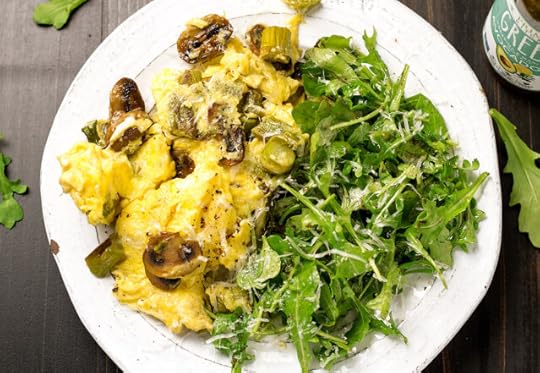
Meal 5: Chicken Noodle Soup

What You’ll Need…
Shopping List:
4 pounds/1.8 kilograms beef chuck roast
1 rotisserie chicken
Eggs (half dozen)
1 package/7 ounces/200 grams shirataki angel hair noodles
2 onions
1 head garlic
2 pounds/1 kilogram asparagus
4 medium zucchini
8 ounces/226 grams sliced mushrooms
1 12- to 16-ounce/453-gram bag frozen cauliflower rice
1 package shredded red or green cabbage (coleslaw)
1 6-ounce/170-gram bag arugula
2 limes
2 avocados
1 jalapeno
Cilantro
Basil
Thyme
3 cups (24 fluid ounces) beef stock
8 cups (64 fluid ounces) chicken stock
1 can coconut milk (13.5 fluid ounces/400 ml)
1 bay leaf
Curry powder (1 tablespoon/15 milliliters)
Cumin (1 teaspoon/5 milliliters)
Chili powder (1 teaspoon/5 milliliters)
Salt and pepper
Primal Kitchen® Avocado Oil and/or extra virgin olive oil
Coconut oil
Soy sauce or tamari or coconut aminos (2 tablespoons/30 milliliters)
Red wine vinegar (1 tablespoon/15 milliliters)
Slivered almonds (1 cup/300 grams)
Parmigiano-Reggiano cheese (1 cup/90 grams grated)
Primal Kitchen Honey Mustard Vinaigrette (or your favorite homemade vinaigrette)
Tools:
Instant Pot
3 half-size rimmed sheet pans (13”x18”)
Parchment paper or foil (for easier cleanup)
Here’s the Plan…
Prep and Cook the Meat:
First, get the pot roast going because it takes the longest amount of time to cook. Season the beef by rubbing 1 heaping teaspoon salt and ½ teaspoon black pepper into the roast.
Roughly chop two onions. Use one chopped onion for the pot roast and set the other aside for later.
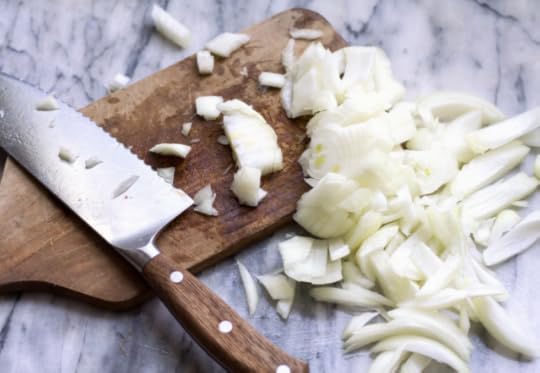
Peel 6 cloves garlic and smash them with your palm.
Turn the Instant Pot sauté setting to high. Drizzle a tablespoon or two of avocado oil into the pot. Put the roast in the Instant Pot and sprinkle one chopped onion around it.
Sear the meat, turning as needed, until all sides are nicely browned (about 2 minutes per side). Mix the onions occasionally, so they become soft and nicely browned.

Add the garlic cloves, 3 cups beef stock, 1 tablespoon red wine vinegar, a few sprigs of thyme and one bay leaf.
Put the lid on the Instant Pot and set the pressure release valve to “sealing.” Use the manual setting to cook on high pressure for 50 minutes. When 50 minutes is up, let the pressure release naturally.
When the pot roast is done, remove it from the Instant Pot and let the meat cool on a cutting board. Shred the meat and store in two separate food storage containers for two separate meals.
While the pot roast is cooking, get to work on the other ingredients.
Prep and Cook the Sheet Pan Veggies:
Heat oven to 425ºF/218ºC.
Cover three sheet pans with parchment paper (optional, for easier cleanup).

Sheet Pan #1: Trim the bottom off the asparagus stalks. Lay the asparagus out on a sheet pan. Lightly coat the asparagus with oil and salt.
Sheet Pan #2: Slice the zucchini into ½-inch rounds. Combine on a sheet pan with the chopped onion that was set aside earlier. Lightly coat zucchini and onion with oil and salt.
Sheet Pan #3: Spread the sliced mushrooms out on a sheet pan. Lightly coat mushrooms with oil and salt.
Put all three of the sheet pans in the oven. Roast for 20 to 35 minutes, stirring occasionally, until vegetables are tender and lightly browned.
While the veggies are roasting, make the coconut curry sauce.
Make the Curry Sauce:
To make the coconut curry sauce, heat a few tablespoons coconut oil in a pot over medium heat. Add 3 finely chopped garlic cloves. Add 1 tablespoon curry powder and sauté 30 seconds. Add 1 can coconut milk and 2 tablespoons soy sauce (or tamari or coconut aminos). Bring to a boil then turn the heat down slightly and simmer 15 to 20 minutes.
While the curry sauce is simmering, slice the white meat from the rotisserie chicken and chop into small pieces. Add to the coconut curry sauce.
Organize the Ingredients For the Week:
Pull all of the dark meat from the rotisserie chicken. Put the dark meat in a zip-top freezer bag.
When the veggies are done, let them cool. Store the asparagus and mushrooms in separate food storages container and refrigerate.
Add half of the zucchini and onion to the coconut curry sauce. Store the coconut curry sauce (with chicken, zucchini and onion) in a food storage container (or just keep it in the pot!) and put it in the refrigerator.
Add the other half of the zucchini and onion to the freezer bag with the dark chicken meat. Make sure to push out all the air when sealing the plastic bag. Put the bag in the freezer.
Serve Your Meals:
Meal #1: Pot Roast with Roasted Asparagus and Honey Mustard Slaw
Serve half of the pot roast with half of the roasted asparagus. Toss half of the shredded cabbage with a few handfuls of arugula. Dress the slaw with Primal Kitchen Honey Mustard Vinaigrette, or your favorite homemade salad dressing. Sprinkle slivered almonds over the asparagus and slaw.

Meal #2: Chicken Coconut Curry over Cauliflower Rice
Reheat the chicken coconut curry over medium heat. Heat the frozen cauliflower rice either in the microwave or in a sauté pan. Serve the curry over the cauliflower rice and garnish with fresh basil.

Meal #3: Beef Carnitas with Spicy Jalapeño Slaw and Guacamole
Reheat the remaining pot roast by adding the shredded meat to a hot skillet with a thin layer of oil. Cook until the meat is hot and a little bit crispy. As the meat cooks, season it with 1 teaspoon of cumin and chili powder. Mash 2 avocados with lime juice and salt to make guacamole. Add a sliced jalapeño to the remaining sliced cabbage, tossed with lime juice and fresh cilantro.

Meal #4: Asparagus and Mushroom Scramble with Arugula Salad
Chop the leftover asparagus into ½-inch pieces. Sauté asparagus and mushrooms in a skillet with a little bit of oil to reheat. Whisk 6 eggs and add to the pan, stirring to combine with the veggies. Serve the scramble with a side salad made from the remaining arugula and your favorite salad dressing. Grate Parmigiano-Reggiano cheese over the scramble and salad.

Meal #5: Chicken Noodle Soup
Put the frozen dark chicken meat and zucchini in the refrigerator in the morning to defrost. At dinnertime, heat 8 cups chicken broth. Add the chicken and zucchini with rinsed shirataki noodles and simmer until warm.

Thanks for reading today. What cooking tips or meal prep ideas are you looking for? Share what you’d like to see us cover in future recipe and cooking articles in the comment board below.

The post 90-Minute Low-Carb, Keto Meal Prep appeared first on Mark's Daily Apple.



October 23, 2019
5 Biggest Longevity Myths
 Older people (and those headed in that direction, which is everyone else) are really sold a bill of goods when it comes to health and longevity advice. I’m not a young man anymore, and for decades I’ve been hearing all sorts of input about aging that’s proving to be not just misguided, but downright incorrect. Blatant myths about healthy longevity continue to circulate and misinform millions. Older adults at this very moment are enacting routines detrimental to living long that they think are achieving the opposite. A major impetus for creating the Primal Blueprint was to counter these longevity myths. That mission has never felt more personal.
Older people (and those headed in that direction, which is everyone else) are really sold a bill of goods when it comes to health and longevity advice. I’m not a young man anymore, and for decades I’ve been hearing all sorts of input about aging that’s proving to be not just misguided, but downright incorrect. Blatant myths about healthy longevity continue to circulate and misinform millions. Older adults at this very moment are enacting routines detrimental to living long that they think are achieving the opposite. A major impetus for creating the Primal Blueprint was to counter these longevity myths. That mission has never felt more personal.
So today, I’m going to explore and refute a few of these top myths, some of which contain kernels of truth that have been overblown and exaggerated. I’ll explain why.
1) “Don’t Lift Heavy: You’ll Throw Out Your Back”
Obviously, a frail grandfather pushing 100 shouldn’t do Starting Strength right off the bat (or maybe ever, depending on how frail he is). That’s not my contention here. My contention:
Lifting as heavy as you can as safely as you can is essential for healthy longevity. That’s why I put it first in the list today. It’s that important.
For one, lean muscle mass is one of the strongest predictors of resistance to mortality. The more muscle a person has (and the stronger they are), the longer they’ll live—all else being equal. That’s true in both men and women.
One reason is that the stronger you are, the more capable you are. You’re better at taking care of yourself, standing up from chairs, ascending stairs, and maintaining basic functionality as you age.
Another reason is that increased lean mass means greater tissue reserve—you have more organ and muscle to lose as you age, so that when aging-related muscle loss sets in, you have longer to go before it gets serious. And that’s not even a guarantee that you’ll lose any. As long as you’re still lifting heavy things, you probably won’t lose much muscle, if any. Remember: the average old person studied in these papers isn’t doing any kind of strength training at all.
It doesn’t have to be barbells and Olympic lifts and CrossFit. It can be machines (see Body By Science, for example) and bodyweight and hikes. What matters is that you lift intensely (and intense is relative) and safely, with good technique and control.
2) “Avoid Animal Protein To Lower IGF-1”
Animal protein has all sorts of evil stuff, they say.
Methionine—linked to reduced longevity in animal models.
Increased IGF-1—a growth promoter that might promote unwanted growth, like cancer.
Yet, a huge study showed that in older people, those 65 or older, increased animal protein intake actually protected against mortality. The older they were and the more protein they ate, the longer they lived.
Meanwhile, low-protein diets have been shown to have all sorts of effects that spell danger for older people hoping to live long and live well:
Slow the metabolism, increase insulin resistance, and cause body fat gain.
Impair the immune system and make infections more severe.
Reduce muscle function, cellular mass (yes, the actual mass of the cell itself), and immune response in elderly women.
Impair nitrogen balance in athletes.
Increase the risk of osteoporosis.
Increase the risk of sarcopenia (muscle wasting).
And about that “excess methionine” and “increased IGF-1”?
You can easily (and should) balance your methionine intake with glycine from collagen, gelatin, or bone broth. In animals, doing so protects against early mortality.
In both human and animal studies, there’s a U-shaped relationship between IGF-1 levels and lifespan. Animal studies show an inverse relationship between IGF-1 and diabetes, heart disease, and heart disease deaths (higher IGF-1, less diabetes/heart disease) and a positive association between IGF-1 and cancer (higher IGF-1, more cancer). A recent review of the animal and human evidence found that while a couple human studies show an inverse relationship between IGF-1 and longevity, several more show a positive relationship—higher IGF-1, longer lifespan—and the majority show no clear relationship at all.
3) “You’re Never Getting Back That Cartilage—Once It’s Gone, It’s Gone”
Almost every doctor says this. It’s become an axiom in the world of orthopedics.
But then we see this study showing that people have the same microRNAs that control tissue and limb regeneration in lizards and amphibians. They’re most strongly expressed in the ankle joints, less so in the knees, and even less so at the hip—but they’re there, and they’re active.
I’ve seen some impressive things, have been able to personally verify some stunning “anecdotes” from friends and colleagues who were able to regrow cartilage or at least regain all their joint function after major damage to it. Most doctors and studies never capture these people. If you look at the average older person showing up with worn-down joints and degraded or damaged cartilage, how active are they? What’s their diet?
They are mostly inactive. They are often obese or overweight.
They generally aren’t making bone broth and drinking collagen powder. They aren’t avoiding grains and exposing their nether regions to daily sun. They aren’t doing 200 knee circles a day, performing single leg deadlifts, and hiking up mountains. These are the things that, if anything can, will retain and regrow cartilage. Activity. Letting your body know that you still have need of your ankles, knees, and hips. That you’re still an engaged, active human interacting with the physical world.
4) “Retire Early”
This isn’t always bad advice, but retiring and then ceasing all engagement with the outside world will reduce longevity, not increase it. Having a life purpose is essential for living long and living well; not having one is actually an established risk factor for early mortality. And at least when you’re getting up in the morning to go to work, you have a built-in purpose. That purpose may not fulfill your heart and spirit, but it’s a purpose just the same: a reason to get up and keep moving.
Retiring can work. Don’t get me wrong. But the people who retire early and make it work for their health and longevity are staying active. They’re pursuing side projects or even big visions. They have hobbies, friends, and loved ones who they hang out with all the time.
The ones who don’t? Well, they are at at increased risk of dying early.
You don’t have to keep working a job you hate, or even a job you enjoy. You can retire. Just maintain your mission.
5) “Take It Easy As You Get Older”
As older people, we’re told that sex might be “too strenuous for the heart” (Truth: It’s good for it). We’re told to “take the elevator to save our knees.” They tell us “Oh, don’t get up, I’ll get it for you.”
They don’t tell me that because, well, I’m already up and doing the thing. I’m active and obviously so. I don’t take it easy.
Stay vigorous, friends. Stay vivacious. Don’t be foolhardy, mind you. Be engaged.
“Take it easy” quickly becomes “sit in the easy chair all day long watching the news.” Don’t let it happen.
That’s not to say you shouldn’t rest. Rest is everything. Sleep is important. But you must earn your rest, and when you have the energy, take advantage of it. Don’t rest on your laurels.
As you can see, there are tiny kernels of truth in many of these myths. We should all be careful lifting heavy things and pay close attention to technique and form. Everyone should care for their cartilage and avoid damage to it. No one should continue working a job that sucks their soul and depletes their will to live if they can move on from it. And so on.
What we all need to avoid is sending the message to our brain, body, and cells that we’re done. That we’ve given up and our active, engaged life is effectively over. Because when that happens, it truly is over.
Someone asked me when aging begins. How old is “old”?
I think I know now. Aging begins when you start listening to conventional longevity advice. As I said on Twitter earlier today, healthy aging begins when you do the opposite.
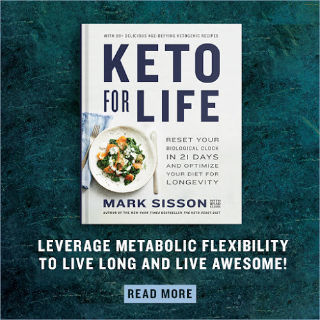 Want more on building a life that will allow you to live well into later decades? I definitely have more on that coming up. A perceptive reader shared the news in one of the Facebook groups already, so let me mention it here. My new book, Keto For Life: Reset Your Biological Clock In 21 Days and Optimize Your Diet For Longevity, is coming out December 31, 2019. I’ll have more info, including a special bonus package for those who preorder, in just a few weeks. In the meantime, you can read more about it here on our publisher’s page.
Want more on building a life that will allow you to live well into later decades? I definitely have more on that coming up. A perceptive reader shared the news in one of the Facebook groups already, so let me mention it here. My new book, Keto For Life: Reset Your Biological Clock In 21 Days and Optimize Your Diet For Longevity, is coming out December 31, 2019. I’ll have more info, including a special bonus package for those who preorder, in just a few weeks. In the meantime, you can read more about it here on our publisher’s page.
That’s it for today, friends. Chime in down below about longevity or any other health topics you’re thinking about these days. What are the most egregious aging myths you’ve heard? What do you do instead? Take care.

References:
Karlsen T, Nauman J, Dalen H, Langhammer A, Wisløff U. The Combined Association of Skeletal Muscle Strength and Physical Activity on Mortality in Older Women: The HUNT2 Study. Mayo Clin Proc. 2017;92(5):710-718.
Malta A, De oliveira JC, Ribeiro TA, et al. Low-protein diet in adult male rats has long-term effects on metabolism. J Endocrinol. 2014;221(2):285-95.
Carrillo E, Jimenez MA, Sanchez C, et al. Protein malnutrition impairs the immune response and influences the severity of infection in a hamster model of chronic visceral leishmaniasis. PLoS ONE. 2014;9(2):e89412.
Castaneda C, Charnley JM, Evans WJ, Crim MC. Elderly women accommodate to a low-protein diet with losses of body cell mass, muscle function, and immune response. Am J Clin Nutr. 1995;62(1):30-9.
Gaine PC, Pikosky MA, Martin WF, Bolster DR, Maresh CM, Rodriguez NR. Level of dietary protein impacts whole body protein turnover in trained males at rest. Metab Clin Exp. 2006;55(4):501-7.
Wu C, Odden MC, Fisher GG, Stawski RS. Association of retirement age with mortality: a population-based longitudinal study among older adults in the USA. J Epidemiol Community Health. 2016;70(9):917-23.
The post 5 Biggest Longevity Myths appeared first on Mark's Daily Apple.



10 Autumn Breakfasts To Warm Your Morning
 Whether you’re a big breakfast person or not, everyone enjoys something warm and comforting in the morning, right?
Whether you’re a big breakfast person or not, everyone enjoys something warm and comforting in the morning, right?
From Primal pancakes to frittatas, we’ve got 10 delicious ideas for those who crave the savory or the sweet—as well as some filling coffees for those who prefer to keep the routine simple and the fare light in the a.m.
Enjoy any of these great dishes and drinks anytime of the day….
1) Butternut Squash Waffles

2) Vegetable Latkes

3) Egg Coffee

4) Apple Cinnamon Primal Pancakes

5) Bacon Pancakes
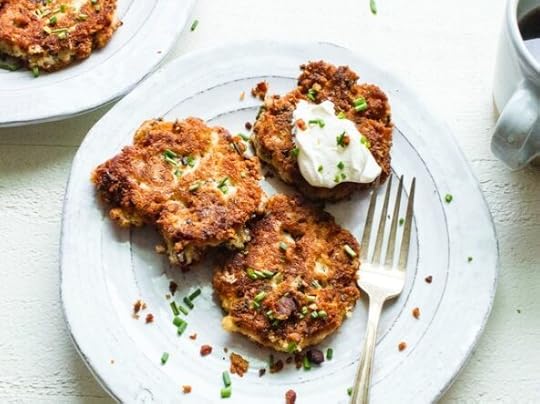
6) Pumpkin Spice Collagen Latte

7) Sweet Potato Toast With Avocado and Egg

8) Almond Butter Banana Pancakes

9) Curried Pork Frittata

10) Grain-Free Pumpkin Spice Granola

Have a favorite Primal or keto breakfast or questions about what to eat in the a.m.? Share your ideas and inquiries below.

The post 10 Autumn Breakfasts To Warm Your Morning appeared first on Mark's Daily Apple.



October 22, 2019
Campfire Cooking: A Primal Guide
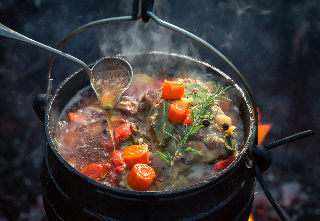 For hundreds of thousands of years, humans had an unbroken tradition of evening firesides. It’s where we told stories, recounted the happenings of the day, sang, danced, and just sat in comfortable silence staring into the flames. It’s also where we graduated from desperate scavengers scooping half-eaten marrow and gnawing bone scraps for gristly morsels into legitimate cooks.
For hundreds of thousands of years, humans had an unbroken tradition of evening firesides. It’s where we told stories, recounted the happenings of the day, sang, danced, and just sat in comfortable silence staring into the flames. It’s also where we graduated from desperate scavengers scooping half-eaten marrow and gnawing bone scraps for gristly morsels into legitimate cooks.
Now that line is broken. Now we sit around the television. We sit under the perma-glow of the LED, gazing into our phones. If we even cook, we do it under perfectly controlled settings. Which is fine, but it’s missing something: the wildness of fire.
Cooking over a campfire is more art than science. It’s feel. It’s intuition. It’s love. Every flame is unique, every piece of wood or charcoal providing a different amount of heat. No two steaks or slices of bacon are identical cooked over flame or charcoal, yet each is perfect in its own way. It always works out.
First of all, you don’t need to actually go camping to do campfire cooking. It certainly helps, and I highly recommend camping as often as you can, but you can cook over fire almost anywhere, anytime.
Here’s what to do….
How To Get Set Up
Watch the Francis Mallmann Episode Of Netflix’s “Chef’s Table”
If you have Netflix, watch it. It’s from the first season. This trailer gives you a taste of what to expect.
Mallmann is an Argentine chef who cooks exclusively using wood fire. He’s a bit of a romantic, always wearing colorful cloaks and elaborate hats and quoting poetry and things like that, but somehow it works with him. He’ll have you wanting to start flirting with the “edge of uncertainty” that is campfire cooking.
Get a Fire Pit
Buy one if you like. I haven’t come across any great cooking commercial fire pits, but I’m sure they’re out there.
You can get some old steel drums and either cut the tops off, or lay them on their side and cut from top to bottom to create a “trough” style pit. Make sure to clean the inside and (this is important) only use unlined drums—you don’t want any toxic material coating the interior. Give it a good hot fire or two to burn off any unwanted residues.
You can find a metal fabricator nearby who’ll build whatever you want. Bring a sketch (or detailed description) of your desired fire pit and he or she will build exactly what you envision.
Horizontal smokers work, too, if the trough section is big enough for a fire.
A basic Weber-style charcoal grill can also work well, handling either wood fires or charcoal.
Or, for the most Primal experience, you could build one on the ground. Make a ring of stones, shape it into whatever arrangement you’d feel best cooking on, and get cooking. Have a source of water nearby (hose, huge bucket) so you can douse the thing if it gets out of hand.
Get Some Cast Iron
There’s something extremely romantic about cooking in black iron over fire. It feels Primal, elemental, and ancient. Plus, cast iron can handle the worst fire you can throw at it and turn it into something beautiful and delicious.
Get a grill, like this one: Raichlen’s Tuscan grill—a 14 inch by 14 inch square cast iron grill with screw on legs, so you can place it directly in the fire and either cook right on the grill or use it as a stand for your pan or griddle. I’ve used this thing to cook meat right in the sand as the sun drops. Nothing like it.
Get some pans: I like a 12 inch cast iron pan and a 15 inch cast iron pan—good sizes but still maneuverable (albeit heavy). If you’re feeding more people or need to cook 4-5 steaks at once, think about getting a really huge piece like this 20-incher or maybe the 17 incher from Lodge. You can often find better deals (and unique pieces) at garage sales, antique sales, or off of Craigslist.
Get a griddle: A big flat rectangular slab of iron is also pretty great, if you prefer that shape to the round pan. Your mileage may vary. Or get both!
Build a Fire
For cooking, I like the log cabin setup. You need a big fire pit to do this, and it consumes a lot of wood, but it really creates a hot flame and, if you plan on cooking over it (see the next section), great embers in a short amount of time. Start with two large pieces across from each other. Stack two more across the top on the other sides, forming a square. Continue until you’ve got a 1-2 foot structure. Then, place a small tipi inside the “cabin” and light it. Place small kindling-size pieces across the top of the “cabin” to increase the fuel.
Here’s a nice video of one.
Choose Hardwoods
Oak is probably the best to cook over. Almond and madrone are also great. Neutral taste, powerful heat.
Don’t cook over wood like redwood or bay or eucalyptus. Anything with strong resin or sap will flavor your food, and not in a good way. Although some Caribbean jerk recipes use bay for flavor, a little bit goes a long way.
Straight up charcoal is another option. It’s not as romantic or thrilling as building a fire and seeing it cook down into embers, but it does the trick.
You’re ready to go. Your fire is blazing. Embers are developing. What’s next?
What To Cook
Steak
The quintessential campfire meal is grilled steak. Or seared—read on. Some salt, some pepper, some fat, some fire, and some iron. It’s easy. It’s delicious. And it’s highly satisfying.
What kind of steaks?
They all work. I’d reserve the pricy stuff like NY strips, ribeyes, and porterhouses for a later date, for when you’re more skilled around the campfire, and stick with cheaper (but no less delicious) cuts in the beginning.
Skirt
Chuck Eye
Flat Iron
Picanha, or Petite Sirloin (a section of the sirloin with a big fat cap on it)
Cook this with salt and pepper on your cast iron pan, which should be screaming hot before you add the steaks. Flip once, press the center, and when it feels right, it’s done. Don’t use a thermometer. Go by feel. Trust your instincts. If they’re wrong, they will hone themselves and the next one will be better. You don’t want to be the person who’s fussing and fretting with fancy thermometers over the campfire, do you?
You can grill over the grates, but I really think a pan works better here. Any marinated steak, however, seems to work better over a grill.
And these all apply, of course, to other types of animal flesh: lamb leg steaks or chops, pork chops or loin, venison (preferably backstrap from an animal just killed).
Stews
I hereby declare that the category of “stews” includes chili, curry, pot roasts, and anything else you cook in a big old pot with liquid that’s hearty, rich, and thick and isn’t soup.
This is the best chili to make over a campfire.
This is a great lamb curry.
I love this German pot roast over the fire. Since the liquid will evaporate quicker than in the oven, you’ll need to keep some bone broth on hand to keep adding to the pot as it disappears. It actually ends up better and richer than the oven version due to the added gelatin.
I once came up with a stew using camp leftovers that I’ll probably never be able to recreate, but this was the gist:
Chop some bacon and render the fat in a dutch oven.
A whole chicken, salted and browned on all sides in said dutch oven.
Throw in a mess of chopped veggies—garlic, peppers, onions, leeks, carrots, lemon slices—and brown them in the fat.
Pour half a bottle of white wine in and half a hard cider or beer.
Pour in some vinegar and fish sauce.
Pour in some canned/jarred tomatoes or tomato puree. Paste would also work.
Then let it cook down. Put the wooden spoon in it and cover it, so that the steam can escape and the stew can thicken. It’s ready when the meat is falling off the bone, the broth is thick, and the bones are softening.
The beauty of this one was that we kept adding ingredients throughout the cook as we discovered them and went “hey, this might be good!” Yours might not turn out the same, but it will be great. Probably works well with any hunk of meat, as long as it has bone and connective tissue—think oxtails, shanks, legs, feet.
The problem with making dishes like this in the kitchen is that it’s terribly boring standing there for hours monitoring its progress. The beauty of making dishes like this over the campfire is that it’s not. You’ve got friends pitching in, taking turns with the spoon. You have a beverage. You’re laughing, chatting, talking. You can always just gaze at the trees. It’s a communal event. If you can, extend the cook time of all these dishes. Really let the fire and smoke soak into the stew.
Veggies
Veggies are to be cooked as the meat is resting, preferably using the same pan in the same fat. A few ideas:
Vegetable “Risotto”: Chop peppers (both hot and sweet and mild), slice onions, some green tomatoes, some leeks and shallots (basically all the alliums you can find), carrots, cherry tomatoes. Throw in a few whole garlic cloves (or a few dozen). Cook in the meat drippings and as it cooks down, add little scoops of hot bone broth. That’s the “risotto” part—continually adding hot broth to reduce down into syrup. Consider a splash or two of lemon juice at the end, if it needs acidity.
Crispy Asparagus: Chop asparagus up into four pieces, each about two inches long. In either avocado oil or the meat drippings, sauté the asparagus pieces until browned and crispy. Finish with sea salt and lemon juice.
Grilled Zucchini: Slice big vertical slices about a finger width thick. Brush with avocado oil and plenty of salt and pepper. Grill over a grate until you get char marks. Flip, repeat, eat. Zucchini is surprisingly low carb and very high in potassium.
Dessert
I tend to let loose with the sweet stuff a bit more when camping, reason being I’ve been incredibly active, my circadian rhythm is on point from lack of artificial lighting, and sweet stuff just tastes better when it’s a rarity. And even this “sweet stuff” isn’t all that sweet compared to what most people are eating daily.
Whipped cream: Keep metal bowl on ice, pour in cream, maybe add a splash of bourbon or rum, add a little sweetener (real sugar, monkfruit powder, honey, etc.—less is more), and whisk. Pass the bowl around the group for everyone to whisk, since your forearms are probably tired from hauling around cast iron.
Grilled Fruit:
Pears studded with cloves. Cut pears in half. Shove a clove or two into each half. Sear in butter on cast iron and sprinkle of salt. Serve with whipped cream.
Mandarin oranges seared with rosemary. Sprig of rosemary on top the orange, sear in butter. Serve with whipped cream.
Apples in pork fat. If you’ve been cooking pork or bacon, save the fat to cook apple slices in. Sprinkle cinnamon and maybe some cayenne. Serve with whipped cream.
Primal Chocolate Cake: This never fails to please. Cook a Japanese sweet potato by wrapping in foil and burying it in the coals and ashes, making sure to poke a hole down the middle with a chopstick first to provide an avenue for heat down the middle. When it’s ready, cut in half, stick some 85% dark chocolate pieces into the flesh, sprinkle with salt, and mash. Eat.
Dates Stuffed With Salted Macadamia Nuts: No explanation needed. One or two nuts per date half. Incorporate bacon if you like.
“Pumpkin Pie”: Take the winter squash of your choice (I like honey nut, a better, smaller, sweeter butternut) and bury it in the coals and ashes an hour before you need it. Once it’s done, halve it, deseed it, add a raw egg yolk to each half, sprinkle some ginger/cinnamon/nutmeg, add salt, and mash it up. Top with whipped cream.
The trick with campfire cooking is to make it sort of elaborate but not surgical. Rustic but not “empty can of beans into pot.” It’s a fine balance. It’s riding that edge of uncertainty. You can’t quite define it; you just know it when you taste it.
Take care, everyone, and get out of the city and go camping. Or crowd around the fire in your backyard. Or, heck, go to a park with BBQ grills and make a day of it. It’s not too late. Fall camping is my favorite. It’s the perfect time.
What about you? What do you like to cook over the fire?
Thanks for reading. Be well. And let me know how your campfire goes.

The post Campfire Cooking: A Primal Guide appeared first on Mark's Daily Apple.



October 21, 2019
I Changed My Relationship With Food
It’s Monday, everyone! And that means another Primal Blueprint Real Life Story from a Mark’s Daily Apple reader. If you have your own success story and would like to share it with me and the Mark’s Daily Apple community please contact me here. I’ll continue to publish these each Monday as long as they keep coming in. Thank you for reading!

Yup, success stories are back! And I’m looking for more. Follow-ups, mid-progress reflections—every story at every stage has the potential to inspire folks out there who are getting started or contemplating a new beginning. Contact me here to share your story—long or not so long. You never know who you’ll impact by doing it. Enjoy, everyone!
They say if you love something you should let it go and if it comes back, it loves you too. Well, apparently excess weight really loves me because every time I let it go, it always seemed to come back! Relationships are complicated. Good ones leave you feeling refreshed and energized, while bad ones leave you feeling broken down, depressed, and anxious. Relationships with food aren’t much different.
In my twenties, I was living on my own and partying. Perhaps a little too hard, because over the course of a few years, I gained and lost over 100 pounds—often in 25-30 pound increments. I’d gain the weight, get frustrated, then attempt to lose it through increased exercise and severe calorie restriction.
This would last for a few months until I hit my goals, but it was simply unsustainable. It further pushed the narrative that in order to lose weight I would need to eat a steady diet of plain chicken breasts, salads, and low-fat yogurt while torching calories on the trails. I knew I didn’t want to do that forever.
By 2016, I was married with two young children. Between kids and our careers (I worked as a residential house painter), life got pretty stressful, and what I ate didn’t help. My breakfasts consisted of a bacon, egg, and cheese bagel and mozzarella sticks. And lunch was typically fast food or from a gas station. I would carry around jelly beans in my pocket and loved craft beer. Everyone else was overweight, so why not me too?
It wasn’t until later that year that I started to change my relationship with food.
 I caught wind of the keto diet and suddenly realized that all of the modern day convenience foods I was eating were derailing my health goals. Within a few months of following a keto diet, I effortlessly lost nearly 40 pounds. (You can read more about my keto journey in this MDA post.) I learned everything I could by reading books and listening to podcasts. I even started a Facebook group where our members have collectively lost more than 4,000 pounds to date!
I caught wind of the keto diet and suddenly realized that all of the modern day convenience foods I was eating were derailing my health goals. Within a few months of following a keto diet, I effortlessly lost nearly 40 pounds. (You can read more about my keto journey in this MDA post.) I learned everything I could by reading books and listening to podcasts. I even started a Facebook group where our members have collectively lost more than 4,000 pounds to date!
About that time, I began to notice ads about coaching certifications. One of them happened to be for the Primal Health Coach Institute. In the spring of 2017, after being confronted by someone close to me about my lack of “proper nutrition education,” I immediately enrolled in the program and starting my journey to becoming a Primal Health Coach, graduating in the fall.
Clients have been banging my door down to be taught how to achieve effortless weight management. Just kidding! Getting my coaching career off the ground was slower than I expected. I was still working as a residential house painter and had no marketing experience. I thought that if people knew I was a health coach, they’d simply ask to be coached!
Then I had another roadblock. My wife was diagnosed with an Acoustic Neuroma brain tumor, and it was growing rapidly. We spent months focusing on her care and in the spring of 2018, a surgery was scheduled to have it removed. Even after the surgery, I spent much of my time and effort ensuring that she would make a full recovery, which thankfully, she did.
Despite not having the capacity to build a thriving health coaching business during this time, my yearning to have one never ceased. I continued to learn and stay active in the Primal Health Coach community and devoured podcasts and books about primal health.
In the beginning of 2019, I launched a podcast called “The Joe Health Show” featuring stories of people who have used a keto or primal way of eating to lose weight and manage chronic health issues. I also feature fellow Primal Health Coaches who’ve had their own health transformations and now help others dealing with similar struggles.
I focus my efforts on networking with other coaches and giving them a platform to share their story. My thought is that while I may not be the right coach for everyone, I can help spread the word about different health coaches, so people find the one that’s right for them.
In addition to my podcast, I’ve recently started my new “Bee Fit” Personal Health Coaching program and launched a 21-day online program called “Completely 21” that teaches the basics of healthy living decisions, from food and sleep to other lifestyle habits.
I’ve helped countless people overcome chronic health issues, reverse disease, decrease inflammation, lose weight, become more mobile, get off medications, and become more metabolically efficient runners. You can’t put a monetary value on that! Even if I never make another penny from my Primal Health Coach Institute certification, it was money well spent.
– Jonathan Geiman
Jonathan’s listing in the Primal Health Coach Institute Directory
Website: beefitfamily.com
Follow The Joe Health Show @thejoehealthshow on Instagram and Facebook.

Have a story to share? Email me here. Thanks, everybody, and have a great week.

The post I Changed My Relationship With Food appeared first on Mark's Daily Apple.



Mark Sisson's Blog
- Mark Sisson's profile
- 199 followers




